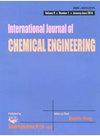Anaerobic Codigestion of Tuber Waste and Fruit Waste: Synergy and Enhanced Biogas Production
IF 2.4
4区 工程技术
Q3 ENGINEERING, CHEMICAL
引用次数: 2
Abstract
Increased urbanization and consumerism have resulted in the excessive release of food waste and municipal solid waste. Such wastes contain abundant organic matter that can be transformed into energy, addressing the twin challenges of waste management and energy insecurity. In recent years, different studies have investigated ways of producing biogas through the codigestion of organic wastes. In this work, different food wastes were codigested and the biogas yield was determined. The effect of feedstock mixing ratios, temperature, and pH was studied. A mixing ratio of 1 : 1 produced the highest biogas yield (2907 ± 32 mL), nearly twice, which was obtained at a ratio of 1 : 4 (1532 ± 17 mL). The biogas yield increased with the temperature rise. The lowest yield of 2907 ± 32 mL was obtained at 20°C, while the highest yield of 4963 ± 54.6 mL was obtained at 40°C. Regarding pH, the yield was 2808 ± 31 mL at pH 6.5 and 7810 ± 86 mL at pH 7.3. This indicated a 178.1% increase in the biogas yield. The CN ratio for tuber waste and fruit waste was 18 and 28, respectively, while the corresponding pH was 6.7 and 6.9. A positive synergy index of 4.5 was obtained, which is higher than what is reported in the literature of codigested substrates. Irish potato peels and banana peels produced the highest biogas yield and are recommended for use as codigested feedstock.块茎废物和水果废物的厌氧共消化:协同作用和提高沼气产量
城市化和消费主义的加剧导致了食物垃圾和城市固体废物的过度释放。这些废物含有丰富的有机物,可以转化为能源,解决废物管理和能源不安全的双重挑战。近年来,不同的研究已经调查了通过有机废物的共处理来生产沼气的方法。在这项工作中,对不同的食物垃圾进行了共消化,并确定了沼气产量。研究了原料混合比、温度和pH的影响。混合比为1 : 1产生了最高的沼气产量(2907 ± 32 mL),几乎两次,以1的比例获得 : 4(1532 ± 17 mL)。沼气产量随温度升高而增加。最低产量2907 ± 32 在20°C下获得mL,而最高产率为4963 ± 54.6 在40°C下获得mL。关于pH,产率为2808 ± 31 mL,pH 6.5和7810 ± 86 mL,pH为7.3。这表明沼气产量增加了178.1%。块茎废弃物和水果废弃物的CN比率分别为18和28,而相应的pH分别为6.7和6.9。获得了4.5的正协同指数,该指数高于共消化底物文献中的报道。爱尔兰土豆皮和香蕉皮产生的沼气产量最高,建议用作共消化原料。
本文章由计算机程序翻译,如有差异,请以英文原文为准。
求助全文
约1分钟内获得全文
求助全文
来源期刊

International Journal of Chemical Engineering
Chemical Engineering-General Chemical Engineering
CiteScore
4.00
自引率
3.70%
发文量
95
审稿时长
14 weeks
期刊介绍:
International Journal of Chemical Engineering publishes papers on technologies for the production, processing, transportation, and use of chemicals on a large scale. Studies typically relate to processes within chemical and energy industries, especially for production of food, pharmaceuticals, fuels, and chemical feedstocks. Topics of investigation cover plant design and operation, process design and analysis, control and reaction engineering, as well as hazard mitigation and safety measures.
As well as original research, International Journal of Chemical Engineering also publishes focused review articles that examine the state of the art, identify emerging trends, and suggest future directions for developing fields.
 求助内容:
求助内容: 应助结果提醒方式:
应助结果提醒方式:


